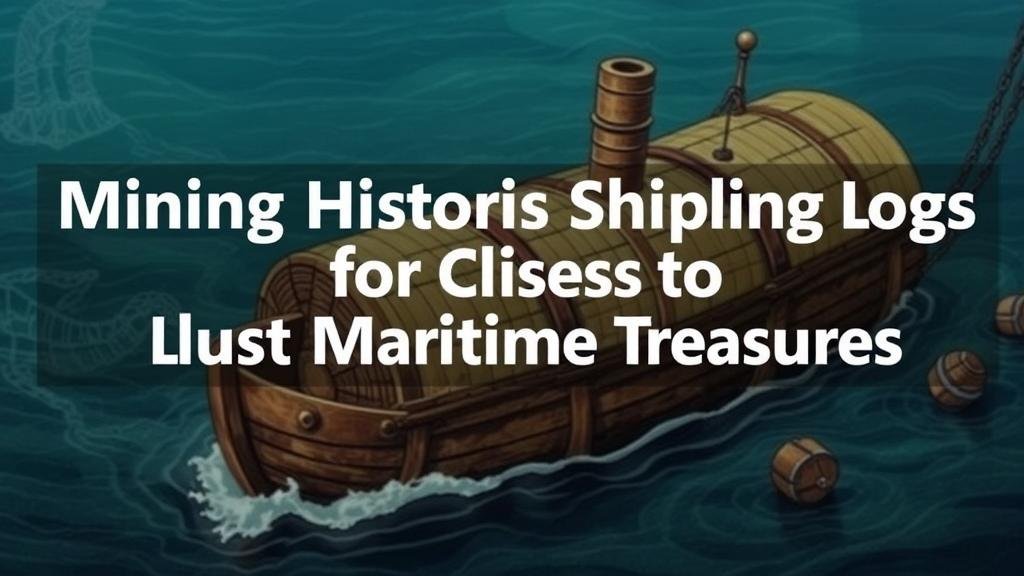Mining Historic Shipping Logs for Clues to Lost Maritime Treasures
Mining Historic Shipping Logs for Clues to Lost Maritime Treasures
The allure of lost maritime treasures has fascinated historians, treasure hunters, and the general public for centuries. The oceans, with their vast and mysterious depths, have concealed a plethora of shipwrecks, cargo, and artifacts from bygone eras. One effective method of locating these treasures is through the analysis of historic shipping logs. This article examines the importance of shipping logs, methodologies for tracing maritime treasures, and examples of successful discoveries.
The Importance of Shipping Logs
Shipping logs serve as official records that detail the movement of vessels, cargo, and passenger information. These documents provide invaluable insights into maritime trade routes, loading and unloading ports, and the types of goods being transported. Understanding the significance of shipping logs is crucial for researchers and treasure seekers alike.
Historical Context of Shipping Logs
Shipping logs date back to the Age of Sail, particularly during the 16th to 19th centuries. For example, English maritime logs from the East India Company shed light on trade between Europe and Asia, while Spanish logs document voyages between the Americas and European ports. These records often include:
- Dates of departure and arrival
- Types of cargo aboard
- Names of crew members and passengers
- Weather conditions encountered during the voyage
The meticulous nature of these logs allows for a reconstruction of historical maritime activities which is essential for locating lost treasures.
Methodologies for Tracing Lost Treasures
The process of mining historic shipping logs for treasure clues involves several methodological steps:
- Data Collection: The first step is to obtain shipping logs from archives or maritime museums. Institutions like The National Archives in the UK and the United States National Archives house extensive collections of historical shipping records.
- Data Analysis: Once the logs are accessed, the next step involves examining the data for mentions of shipwrecks, lost cargoes, or ill-fated voyages. Identifying keywords and notable events can lead to potential treasure sites.
- Geolocational Mapping: By cross-referencing shipping logs with historical maps and modern geolocation tools, researchers can pinpoint exact areas where wrecks may have occurred.
This structured approach allows for a comprehensive view of potential treasure sites based on documented shipping activities.
Case Studies of Successful Discoveries
Several notable treasure discoveries have arisen from the diligent study of shipping logs, illustrating the efficacy of this method.
The Flor de la Mar
One of the most famed shipwrecks is that of the Flor de la Mar, a Portuguese ship that sank off the coast of Malaysia in 1511. Historical records indicate that it was carrying a treasure of gold, silver, and gemstones, valued at approximately $2 billion today. Maritime historians utilized the ships logs and the accounts of survivors to determine the possible wreck site. This case highlights how detailed shipping logs can provide leads on significant treasures.
The San José Galleon
Another significant example is the wreck of the San José, a Spanish galleon that sank in 1708 near Cartagena, Colombia. The ship was laden with gold and precious metals from the New World. By examining shipping logs and historical accounts from that era, researchers identified the ships last known route. wreck was ultimately discovered in 2015, and the treasures estimated value is around $17 billion.
Challenges and Ethical Considerations
While mining historic shipping logs for treasure leads holds great potential, it is not without its challenges. Issues include:
- Incomplete Records: Many shipping logs may be missing or partially damaged, leading to gaps in information.
- Legal and Ethical Concerns: The recovery of maritime treasures often raises questions regarding ownership, cultural heritage, and conservation of artifacts.
Treasure hunters and researchers must navigate these complexities with ethical considerations in mind, striving to preserve historical integrity while pursuing lost treasures.
Conclusion and Actionable Takeaways
Mining historic shipping logs serves as a vital tool in the pursuit of lost maritime treasures. By understanding the historical context of shipping records, employing methodological approaches to analyze them, and learning from successful case studies, both researchers and enthusiasts can enhance their treasure-seeking strategies. Future treasure hunters are encouraged to:
- Engage with maritime archives and museums to access shipping logs.
- Use modern data analysis technologies for geolocation and mapping.
- Maintain awareness of the ethical implications of treasure hunting in maritime archaeology.
As technologies and methodologies advance, the potential for unveiling historical treasures hidden beneath the waves continues to grow, fueled by the insights derived from centuries-old shipping logs.



